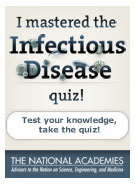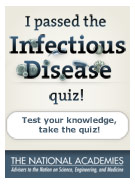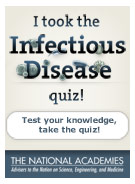
What You Need To Know About Infectious Disease
What do you know about infectious disease?
Public health officials can identify the outbreak of disease by monitoring certain patterns of behavior through syndromic surveillance. Which of the following is one of the signs used to identify a disease outbreak using this system?
- Level of school and work absenteeism
- Sales of over-the-counter medication
- Number of illness-related 911 calls
- All of the above
-
Sorry, that’s incorrect.
In syndromic surveillance, all of the above are used in addition to other patterns that suggest an outbreak. Despite the emergence of this innovative surveillance method, most surveillance still depends on tracking reported infections.
-
Sorry, that’s incorrect.
In syndromic surveillance, all of the above are used in addition to other patterns that suggest an outbreak. Despite the emergence of this innovative surveillance method, most surveillance still depends on tracking reported infections.
-
Sorry, that’s incorrect.
In syndromic surveillance, all of the above are used in addition to other patterns that suggest an outbreak. Despite the emergence of this innovative surveillance method, most surveillance still depends on tracking reported infections.
-
Correct!
In syndromic surveillance, all of the above are used in addition to other patterns that suggest an outbreak. Despite the emergence of this innovative surveillance method, most surveillance still depends on tracking reported infections.
Roughly how many microbes live in the human gastrointestinal tract?
-
Sorry, that’s incorrect.
About ten trillion microbes live in the human gastrointestinal tract. They are essential for proper digestion and absorption of nutrients.
-
Sorry, that’s incorrect.
About ten trillion microbes live in the human gastrointestinal tract. They are essential for proper digestion and absorption of nutrients.
-
Sorry, that’s incorrect.
About ten trillion microbes live in the human gastrointestinal tract. They are essential for proper digestion and absorption of nutrients.
-
Correct!
About ten trillion microbes live in the human gastrointestinal tract. They are essential for proper digestion and absorption of nutrients.
True or False: Our bodies contain at least 10 times more human cells than bacterial cells.
-
Sorry, that’s incorrect.
Our bodies contain at least 10 times more bacterial cells than human cells.
-
Correct!
Our bodies contain at least 10 times more bacterial cells than human cells.
For each child who dies from pneumonia in an industrialized country, about how many children die from the infection in developing countries?
-
Sorry, that’s incorrect.
Life-saving vaccines and medications aren’t distributed equitably around the world; for each child who dies from pneumonia in an industrialized country, more than 2,000 children die from the infection in developing countries.
-
Sorry, that’s incorrect.
Life-saving vaccines and medications aren’t distributed equitably around the world; for each child who dies from pneumonia in an industrialized country, more than 2,000 children die from the infection in developing countries.
-
Sorry, that’s incorrect.
Life-saving vaccines and medications aren’t distributed equitably around the world; for each child who dies from pneumonia in an industrialized country, more than 2,000 children die from the infection in developing countries.
-
Correct!
Life-saving vaccines and medications aren’t distributed equitably around the world; for each child who dies from pneumonia in an industrialized country, more than 2,000 children die from the infection in developing countries.
Which are examples of ways that pathogens (disease-causing microbes) can spread?
- Coughing
- Eating undercooked pork
- Flea bite
- Breathing dust particles containing microorganisms
- All of the above
-
Sorry, that’s incorrect.
All are examples of ways that pathogens can spread. Coughing is an example of airborne droplet transmission; eating undercooked pork is an example of common vehicle transmission; a flea bite is an example of vector transmission; and breathing contaminated dust particles is an example of airborne transmission.
-
Sorry, that’s incorrect.
All are examples of ways that pathogens can spread. Coughing is an example of airborne droplet transmission; eating undercooked pork is an example of common vehicle transmission; a flea bite is an example of vector transmission; and breathing contaminated dust particles is an example of airborne transmission.
-
Sorry, that’s incorrect.
All are examples of ways that pathogens can spread. Coughing is an example of airborne droplet transmission; eating undercooked pork is an example of common vehicle transmission; a flea bite is an example of vector transmission; and breathing contaminated dust particles is an example of airborne transmission.
-
Sorry, that’s incorrect.
All are examples of ways that pathogens can spread. Coughing is an example of airborne droplet transmission; eating undercooked pork is an example of common vehicle transmission; a flea bite is an example of vector transmission; and breathing contaminated dust particles is an example of airborne transmission.
-
Correct!
All are examples of ways that pathogens can spread. Coughing is an example of airborne droplet transmission; eating undercooked pork is an example of common vehicle transmission; a flea bite is an example of vector transmission; and breathing contaminated dust particles is an example of airborne transmission.
True or False: Major pharmaceutical companies have great interest in dedicating resources to the antibiotics market because these short-course drugs are more profitable than drugs that treat chronic conditions and lifestyle ailments, such as high blood pressure or high cholesterol.
-
Sorry, that’s incorrect.
Drugs that treat chronic conditions and lifestyle ailments are more profitable. Modern medicine needs new kinds of antibiotics to treat drug-resistant infections, but antibiotic research and development are expensive, risky, and time-consuming.
-
Correct!
Drugs that treat chronic conditions and lifestyle ailments are more profitable. Modern medicine needs new kinds of antibiotics to treat drug-resistant infections, but antibiotic research and development are expensive, risky, and time-consuming.
Where do microbes live?
-
Sorry, that’s incorrect.
Microbes live in all of these places. They also live in plants and in the air. They can even survive in extreme environments like hot springs, deep ocean thermal vents, and polar ice.
-
Sorry, that’s incorrect.
Microbes live in all of these places. They also live in plants and in the air. They can even survive in extreme environments like hot springs, deep ocean thermal vents, and polar ice.
-
Sorry, that’s incorrect.
Microbes live in all of these places. They also live in plants and in the air. They can even survive in extreme environments like hot springs, deep ocean thermal vents, and polar ice.
-
Sorry, that’s incorrect.
Microbes live in all of these places. They also live in plants and in the air. They can even survive in extreme environments like hot springs, deep ocean thermal vents, and polar ice.
-
Correct!
Microbes live in all of these places. They also live in plants and in the air. They can even survive in extreme environments like hot springs, deep ocean thermal vents, and polar ice.
About how much of its fish and seafood does the United States import?
-
Sorry, that’s incorrect.
The United States imports more than 80 percent of its fish and seafood. About 20 percent of its fresh vegetables and 50 percent of its fresh fruits are imported. As wealthy nations demand such foods year-round, the increasing reliance on producers abroad means that food may be contaminated during harvesting, storage, processing, and transport—long before it reaches overseas markets.
-
Sorry, that’s incorrect.
The United States imports more than 80 percent of its fish and seafood. About 20 percent of its fresh vegetables and 50 percent of its fresh fruits are imported. As wealthy nations demand such foods year-round, the increasing reliance on producers abroad means that food may be contaminated during harvesting, storage, processing, and transport—long before it reaches overseas markets.
-
Correct!
The United States imports more than 80 percent of its fish and seafood. About 20 percent of its fresh vegetables and 50 percent of its fresh fruits are imported. As wealthy nations demand such foods year-round, the increasing reliance on producers abroad means that food may be contaminated during harvesting, storage, processing, and transport—long before it reaches overseas markets.
True or False: Thimerosal, a mercury-containing preservative that was used in some vaccines and other products, has been shown to present a risk to human health.
-
Sorry, that’s incorrect.
The use of thimerosal has been an object of controversy, with some arguing that the substance caused autism in children. However, extensive independent research has presented no convincing evidence of harm associated with the low levels of thimerosal previously present in vaccines.
-
Correct!
The use of thimerosal has been an object of controversy, with some arguing that the substance caused autism in children. However, extensive independent research has presented no convincing evidence of harm associated with the low levels of thimerosal previously present in vaccines.
Thank you for taking our quiz.
Place this badge on your Facebook page to show your friends what you know about infectious disease.
Place this badge on your Facebook page to show your friends what you know about infectious disease.
OR, get a higher score to unlock a different badge.
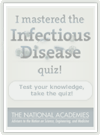
Place this badge on your Facebook page to show your friends what you know about infectious disease.
OR, get a higher score to unlock a different badge.
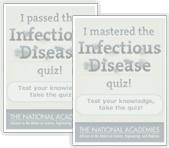
Explore Other Topics
Disease Watchlist
Infectious Disease Defined
- Trachea
The main trunk of the network of tubes that carries air to and from the lungs, sometimes referred to as the “windpipe.”
